Dysrhythmia and pacemaker - Study guides, Class notes & Summaries
Looking for the best study guides, study notes and summaries about Dysrhythmia and pacemaker? On this page you'll find 1252 study documents about Dysrhythmia and pacemaker.
Page 4 out of 1.252 results
Sort by
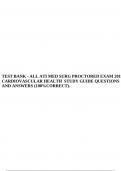
-
TEST BANK - ALL ATI MED SURG PROCTORED EXAM 2019 CARDIOVASCULAR HEALTH STUDY GUIDE QUESTIONS AND ANSWERS (100%CORRECT).
- Exam (elaborations) • 253 pages • 2024
-
- $22.99
- + learn more
TEST BANK - ALL ATI MED SURG PROCTORED EXAM 2019 CARDIOVASCULAR HEALTH STUDY GUIDE QUESTIONS AND ANSWERS (100%CORRECT). ATI MED SURG PROCTORED EXAM 2019 – CARDIO STUDY GUIDE A nurse is performing discharge teaching with a client who has an implantable cardioverter defibrillator (ICD) placed. Which client statement indicates effective teaching? Correct response: • "I'll keep a log of each time my ICD discharges." The nurse is caring for a client scheduled for a transesophageal echoca...
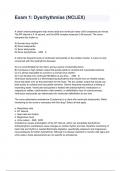
-
Exam 1: Dysrhythmias (NCLEX) Answered Questions
- Exam (elaborations) • 13 pages • 2024
- Available in package deal
-
- $12.99
- + learn more
Exam 1: Dysrhythmias (NCLEX) Answered Questions A client's electrocardiogram strip shows atrial and ventricular rates of 80 complexes per minute. The PR interval is 0.14 second, and the QRS complex measures 0.08 second. The nurse interprets this rhythm is: A) Normal sinus rhythm B) Sinus bradycardia C) Sinus tachycardia D) Sinus dysrhythmia - ANS A A client has frequent bursts of ventricular tachycardia on the cardiac monitor. A nurse is most concerned with this dysrhythmia be...
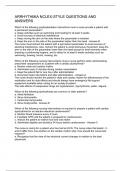
-
ARRHYTHMIA NCLEX-STYLE QUESTIONS AND ANSWERS
- Exam (elaborations) • 7 pages • 2024
-
- $12.99
- + learn more
Which of the following postimplantation instructions must a nurse provide a patient with a permanent pacemaker? a. Delay activities such as swimming and bowling for at least 3 weeks b. Avoid sources of electrical interference c. Keep moving the arm on the side where the pacemaker is inserted d. Keep the arm on the side of the pacemaker higher than the head - Answer-B The nurse must instruct the patient with a permanent pacemaker to avoid sources of electrical interference. Also, instruct th...

-
Cardiac Dysrhythmias Part 2 Test Questions with 100% Complete Solutions, Graded to Pass
- Exam (elaborations) • 23 pages • 2024
-
Available in package deal
-
- $13.99
- + learn more
Describe treatment of dysrhythmias - cORRECT sOLUTION To determine if treatment is necessary, assess the patient. Then ask the following questions: Is he or she experiencing signs and symptoms of decreased cardiac output? Is the dysrhythmia potentially life threatening? If the answer to either of these questions is yes, the patient will need to treatment for the dysrhythmia. ***WE WILL DISCUSS TREATMENTS OF DYSRHYTHMIAS BASED UPON CURRENT ACLS TREATMENT ALGORITHMS CLINICAL MANIFESTATION...

-
Complex Care Final Review 2024 Questions and Answers 100% Pass
- Exam (elaborations) • 39 pages • 2024
- Available in package deal
-
- $13.49
- + learn more
Complex Care Final Review 2024 Questions and Answers 100% Pass The nurse recognizes that primary manifesstations of systolic failure include a. decreased EF and increased PAWP b. decreased PAWP and increased EF c. decreased pulmonary hypertension associated with normal EF d. decreased afterload and decreased left ventricular end-diastolic pressure - Correct Answer ️️ -a A compensatory mechanism involved in HF that leads to inappropriate fluid retention and additional workload of the...
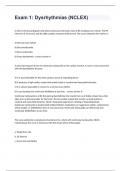
-
Exam 1 Dysrhythmias (NCLEX) Question and answers correctly solved
- Exam (elaborations) • 17 pages • 2024
-
Available in package deal
-
- $13.99
- + learn more
Exam 1 Dysrhythmias (NCLEX) Question and answers correctly solved Exam 1: Dysrhythmias (NCLEX) A client's electrocardiogram strip shows atrial and ventricular rates of 80 complexes per minute. The PR interval is 0.14 second, and the QRS complex measures 0.08 second. The nurse interprets this rhythm is: A) Normal sinus rhythm B) Sinus bradycardia C) Sinus tachycardia D) Sinus dysrhythmia - correct answer A A client has frequent bursts of ventricular tachycardia on the cardiac monit...
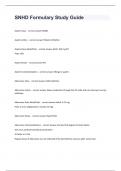
-
SNHD Formulary Study Guide fully solved rated A+
- Exam (elaborations) • 15 pages • 2024
- Available in package deal
-
- $17.99
- + learn more
SNHD Formulary Study Guide Aspirin Class - correct answer NSAID Aspirin Action - correct answer Platelet inhibition Aspirin Dose Adult/Peds - correct answer Adult: 324 mg PO Peds: N/A Aspirin Route - correct answer PO Aspirin Contraindications - correct answer Allergy to aspirin Adenosine Class - correct answer Antiarrhythmic Adenosine Action - correct answer Slows conduction through the AV node and can interrupt re-entry pathways Adenosine Dose Adult/Peds - correc...
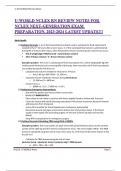
-
Next Generation NCLEX Questions Student File 2023-2024 Exam Revision /U-WORLD NCLEX RN REVIEW NOTES FOR NCLEX NEXT-GENERATION EXAM PREPARATION, 2023-2024 LATEST UPDATE!!! Dysrhythmia and Pacemaker chapters 1-35
- Package deal • 4 items • 2023
-
- $17.99
- + learn more
The nurse is managing assigned clients on the evening shift. Which client presentation is a priority? Unordered Options Ordered Response 1. Blunt head trauma with projectile vomiting 2. History of Alzheimer disease with agitation 3. History of carpal tunnel syndrome with hand numbness 4. History of third cranial nerve pathology with double v

-
DAANCE Exam Questions & 100% Verified Answers | Latest Update | Already Graded A+
- Exam (elaborations) • 35 pages • 2024
- Available in package deal
-
- $14.29
- + learn more
Wave of Depolarization : an advancing wave of charge reversal as the nerve impulse advance a long the neuron Wakefullness system : consists of a central core in the brainstem with neurons that radiate to the cortex Vomiting Center : the center in the brainstem that induces vomiting Vital Centers : centers in the brainstem that control such physiologic processes as blood pressure and pulse, depth and rate of respiration Vestibular nerve : part of the eighth cranial nerve that is conn...

-
Final Test Questions NRCME DOT || 100% correct answers.
- Exam (elaborations) • 9 pages • 2024
- Available in package deal
-
- $11.39
- + learn more
The waiting period after pacemaker implantation for treatment of sinus node dysfunction is __________. One week. Two weeks. One month. Three months. correct answers One month. The maximum thoracic aneurysm size that allows driver certification is _ 3.0 cm 3.5 cm 4.0 cm 5.0 cm correct answers 3.5cm Which of the following is a qualification recommendation following coronary artery bypass graft (CABG) surgery? A. Exercise tolerance testing (ETT) every two years after five years...

Study stress? For sellers on Stuvia, these are actually golden times. KA-CHING! Earn from your study resources too and start uploading now. Discover all about earning on Stuvia


